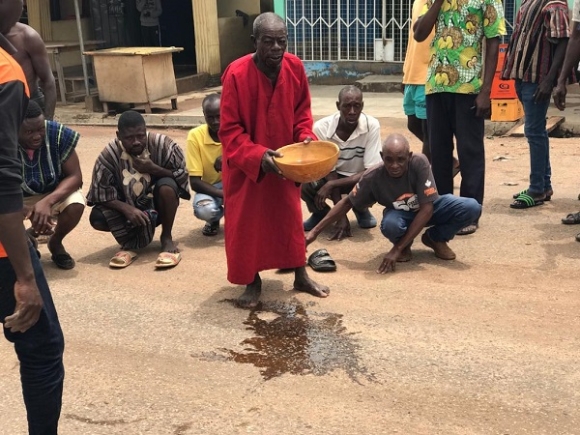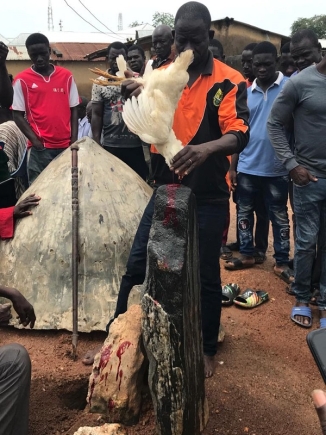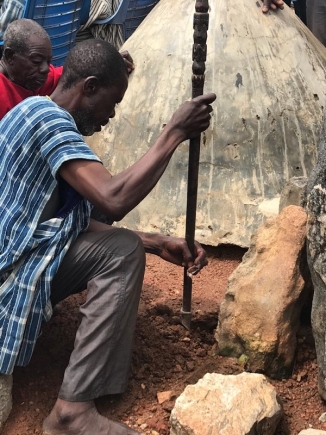
Rituals of the Heukwaara festival in Tuna and Sawla
In the Vagla custom and tradition, each community reveres a supreme god, supported by community gods and lesser deities stationed throughout the community. These divine beings are believed to play crucial roles in safeguarding the community from famine, war, accidents, infertility and misfortune.
Advertisement
The Heukwaara festival is celebrated between late August and early October annually, preceding the guinea corn harvest, as per Vagla culture, tradition and heritage.
This year, the Heuhina (land priests) of Tuna and Sawla, located in the Sawla-Tuna-Kalba district, simultaneously celebrated their annual festival. This celebration involved various rituals, prayers and offerings to their gods, seeking blessings for their lands and its inhabitants.
Preparation for the festival
The preparation for this year's festival, held between Saturday, September 9, 2023 and Thursday, September 14, 2023, were marked by the homecoming of Tuna and Sawla natives, gatherings and the collection of pacification items.
These items included fowls, cereals, livestock, the brewing of pito ( a local beer ) for the gods and the preparation of Kikaaga (steamed cereal flour cooked with the broth of sacrificed fowls and livestock).
Traditionally, preparations commenced with an announcement by the Chief Priest (Heuhig) regarding the festival date. On Saturday, September 9, 2023, fowls were caught, a practice ordained by Vagla tradition to be done on a Saturday.
Each household within the traditional area contributed a fowl for this annual sacrifice. Fowls were captured randomly in Tuna , with no protests from natives. In some instances, natives voluntarily offered fowls as tokens from their households.

On Sunday, September 10, 2023, following the successful capturing of fowls , the Heuhig and elders sent a delegation to settler communities within the Tuna traditional area to collect their contributions. These offerings were gathered at the residences of their respective community heads under the Tuna traditional area.
On Monday, in accordance with custom and tradition, elders met early in the morning to inspect and present the ritual Guinea Corn (Kommia) to the women of the Tuna community. This corn was used to brew the pito for the main event. The Zingo Dance took place on Tuesday night until dawn.
In anticipation of this year's festival, settlers on Tuna lands from communities such as Dakompilabol (Dakompilayir), Gbongbonduori, Siepare, Siitiepuo, Naafa, Baale, and Dana-uri presented contributions necessary for the annual festival. These contributions included fowls, cereals, and other items essential for the yearly sacrifice.
The Vaglikoori (chief) of the Tuna Traditional Area, Jara Vaglikoori Mengu Dacharga, and his Heuhin (land Priest) Siayo Kiipo Mwiiri, led the preparation processes in Tuna.
The Tuna community was led by the President of the Vagla Youth Association, Isaac Mangu, and Lompogo Gilbert, popularly known as Mbii, who served as the assemblyman for Tuna East Electoral area. Mbii also held the role of Constituency Communication Officer of the NPP in the Sawla-Tuna-Kalba Constituency.
The Sawla authority, led by Jara Vaglikoori Daani Salia, Sieayo Heuhin Kipo Ampara, and Gbandi Charles Kipo, the head of Lugra (blacksmiths of Sawla ancestry), visited the community's gods and offered sacrifices to them and the ancestors, seeking blessings and protection for both natives and settlers in area.
Festival's activities
Much like Sawla and other Vagla towns and communities such as Beel (Bole), Gindaabol (Jentilpe), Kunlog (Jelinkon), Soma, Jam, Dabori, Sonnyo, Segezi (Seripe), Nakwaabi, Senyeri, Dagbigu, Gurbol (Grupe), the natives of the Tuna traditional area celebrated the annual Tuna Gbalbii festival in Tuna this year.
As with other Vagla communities during their individual celebrations, the primary focus was to pacify their lands and invoke blessings upon their natives and settlers who accepted them through special prayers.
In Tuna, the Tuna Gbalbii is the supreme god and he is honoured each year for bestowing goodwill upon natives and settlers. This year's celebration, which took place between Saturday, September 9 and September 14, witnessed the people of Tuna expressing their gratitude to their ancestors for guiding them through another year of abundant harvests and good omens, free from calamities.

Main festival
On the main event day, Wednesday, the Heuhin, the Vaglikoori, the elders, youth and representatives of all settler communities within Tuna gathered at the village square (Bosibaang). Here, the fowls captured on Saturday were slaughtered based on their colours and the specific deity they were intended for.
After successfully offering sacrifices to the lesser gods of the Tuna traditional area, the chief priest and elders embarked on a journey to the main shrine known as Tuna Gbalbii, carrying the remaining fowls designated for the sacred god.
As mentioned earlier, until the smaller gods within the area were appeased, the supreme god was not offered sacrifices. Therefore, the Heuhin usually led a group of elders to pay homage to all the smaller gods in town, offering fowls where demanded and necessary.
Usually, the success of these sacrifices to the smaller gods in town paved the way for a select group of qualified elders to proceed into the shrine and offer the mandated sacrifices. In cases where sacrifices to the smaller gods in towns were not successful, the Heuhin and elders couldn't visit the shrine until the success of these sacrifices were ensured. When a fowl is slaughtered during the sacrifice, it is thrown out into the open to struggle and die.In the process of its struggle before its death, it must lay prostrate with its chest facing the sky. When the fowl which was sacrificed fails to lay prostrate, it means the sacrifice was not successful.
Once the chief priest and elders left for the shrine, the women gathered at the residence of the Vaglikoori and chief priest to prepare the “ big TZ” (Kuuzeng).
While awaiting the return of the elders and the chief from the Tuna Gbalbii shrine, other community members, including representatives of settler communities, engaged in traditional activities such as Jiiwa, Kpanna and Dugu. These are cultural dances of the Vagla people often done during recreational activities and after a customary burial of a Vagla native.
These activities continued until the arrival of the Chief Priest and elders from the shrine later in the evening.
Intermittent sounds of the Atumpan, a traditional talking drum of the Vagla and other indigenous people, echoed through the community in the evening, signalling the success of the journey from the Tuna Gbalbii shrine.
Hundreds of people gathered at the residence of the Vaglikoori and Heuhin to welcome them and witness the chief priest's consumption of the Kuuzeng and the drinking of pito. This marked the conclusion of the festival's activities each year.
The festival's climax involved serving the leftover pito each day to the chief priest, vaglikoori, and elders for the next seven days. Exactly a week after the main festival, on the Wednesday of the following week, the chief priest and the elders returned to the shrine with the leftover pito (Sinzie) and some fowls for the final cleansing.



